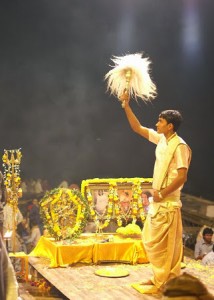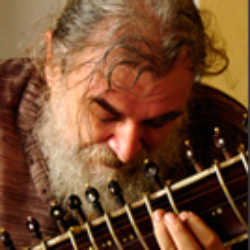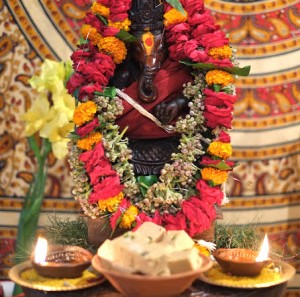As we all know, The Doctrine of Vibration is a very popular book on Kashmir Shaivism (KS), specifically as an introduction to its core concepts. Its publication was based on Dr. Mark Dyczkowski’s doctoral thesis at Oxford. This book, along with The Stanzas on Vibration and The Aphorisms of Siva (Siva Sutra) serves as an essential introductory trilogy for any serious student entering into the world of KS.
While the book is very accessible to everyone, Markji has commented on several occasions that he had several new insights since he wrote the book when he was 28. These insights came over decades of study and practice in the mandala of KS – both its core and the retinue including Kula, Krama and Abhinavagupta’s magnum opus, The Tantraloka. It is in this context he delivered detailed exposition on the doctrine on a weekly basis at Beneras over several months starting October 2013. ATK is delighted to make the recordings available to the extended ATK community.
In the first lecture, Markji begins by providing a detailed developmental context where he weaves epistemology, phenomenology and the ontology into the notions of the integral monism of KS. He presents this by observing the development of forms of Hinduism in the context of individual teachers and groups. For KS, he observes the importance of “Scholar Practitioners” like MM Gopinath Kaviraj, Pt. Rameshwar Jha, Pt. Tripathi etc, in shaping the development of modern KS through traditional scriptural studies. The traditional method, in contrast to modern Hinduism, focuses on continuous reflections on the text which leads to deepening insight that sculpts the very life of the person engaged in the sadhana.
“(Scriptural) study is an initial, but necessary springboard (to deepen spiritual practice)” – Dr. Mark Dyczkowski
He explains the arrival of new forms of tradition centered on Puja (as opposed to traditional Vedic fire sacrifices) around the 5th century C.E, which coincided with the emergence of Shiva to the frontier as the great God along with Vishnu. This further developed into pantheons of systems that included Mantra, Yantra and specific rituals. The upanishadic discussions on ethics and the quest for freedom were interpreted in this new context where impurity is considered as a craving for something more which leads to a delusion where things of no value takes on importance. Thus, as an example, the transitoriness of life takes on importance as permanence. This directly correlates to the ethical dimension that concerns our actions. In these traditions, the regular performing of rituals is meant to remove this impurity. Once a person gets initiated into the Shaiva tradition, he/she continues a lifelong practice to carefully ensure that the impurity does not redevelop.
“The sacred is veiled to our perception because of the barrier of impurity between us and the deity” – Dr. Mark Dyczkowski
In parallel there were notions of the distance between man and God. This distance was considered as a function of the fear of the might of God. As purity develops, the fear and the distance reduces in a virtuous cycle. It is as though as the deity intervenes through grace and frees the individual through purification from ethical darkness. The central concept here is the importance of God as a giver of grace which is also understood as empowerment as impurity renders as powerless. Thus the act of initiation is seen as God empowering the individual through grace thus allowing to maintain the state of purity.
“What is most important is our spiritual state – if our behavior is not up to what it should be in ethical norm, then the solution is to look at our spiritual condition” – Dr. Mark Dyczkowski
Again in parallel, Markji explains that there was another development which developed the courage to go after God’s immense power directly by disregarding the rules of purity and impurity yet to be steadfast with absolute determination. They might

go to the most impure places like cremation ground to invoke the great God and face death directly. It is as if by becoming Tantric, they take the quickest path so they could help others for centuries. This might require special initiations (visesa diksha) above and beyond the basic Shaiva diksha. A form of monism inter threads through these traditions with a clear non-dualism with the deity through the immense vision of God with the help of their master. Such a transmission becomes a tradition for that particular teacher which runs through a lineage.This Markji refers as Integral Monism – an affirmation of oneness of the most intimate and profound relationship with God. By around 8th century C.E, the scriptural traditions advanced to such a degree that there are specific lineages of teachers who chose particular form of revelations. The knowledge in this context can be summarized as “knowledge of the divine” which cannot be accurately expressed (as faith). This also aligns with the way of mastery of yoga which is participating in the expanse of the lord (aishwarya). Thus, the approach of knowledge, yoga and puja/devotion converges into epistemology, phenomenology and ontology. The subject, object and the means of knowledge is seen as the flow of creative consciousness caught up in the interrelationships. It is possible to consider this as an articulation of phenomonlogy through a theory of perception – For Shaivas, God creates through his genius, his Pratiba and the representation / manifestation (world) is the reflection of his genius of creativity.
“In India, metaphysics serves as theoretical framework supporting a body of spiritual discipline. It indicates seekers attitude to his own experience” – Dr. Mark Dyczkowski
For the KS masters, it was important to salvage the reality of the world in order to salvage the reality of God. A phenomenology of appearance and perception of being which is fundamentally expressed in the analogy, the metaphor and the concrete reality of the “Mystic of Light”, a light that is aware of itself in all its tiny details and collectively. With respect and reverence to our teacher, we welcome you to this opportunity through this course.
OM SAUḤ PARĀYAI NAMAḤ


